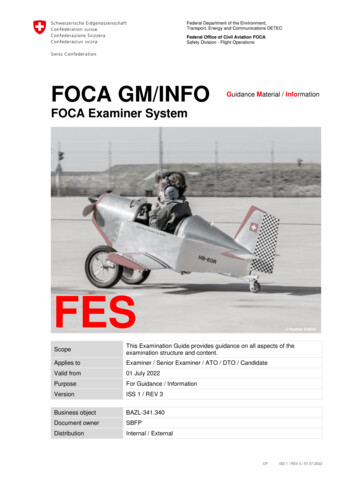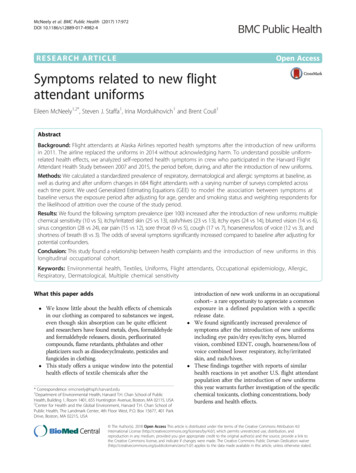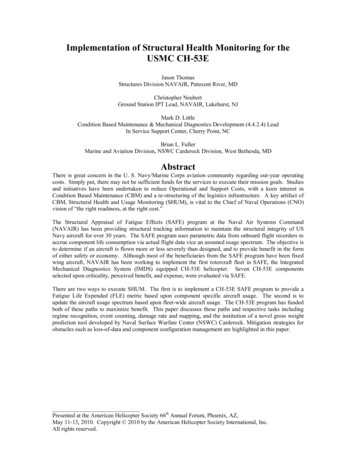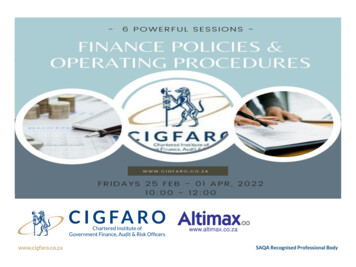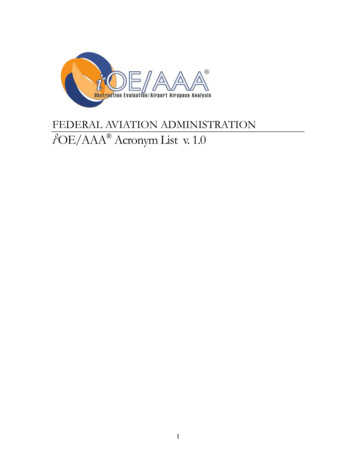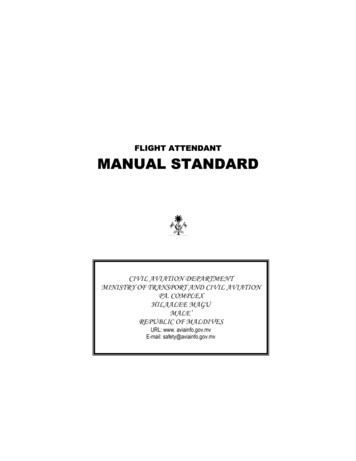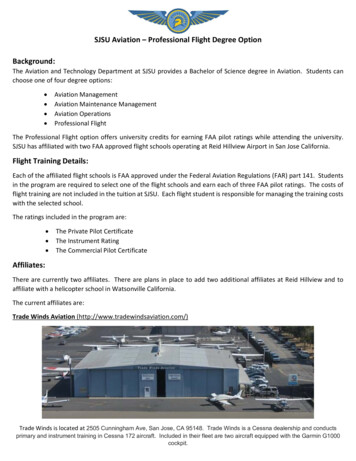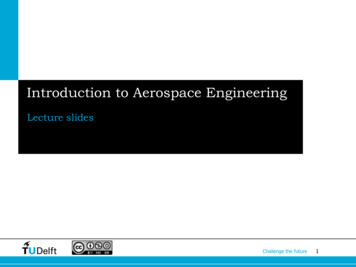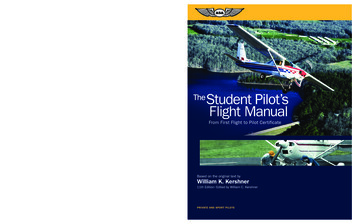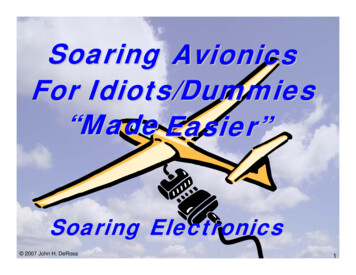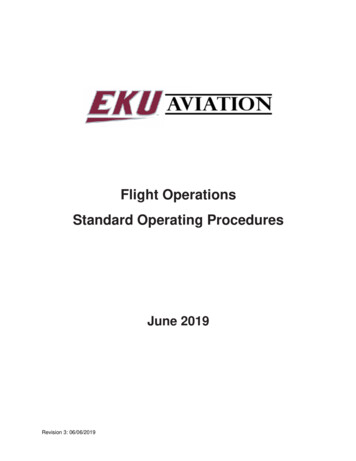
Transcription
Flight OperationsStandard Operating ProceduresJune 2019Revision 3: 06/06/2019
Table of ContentsSection 1 – Introduction1.11.21.3– Operational Directives– Manual Currency– SOP Waiver AuthoritySection 2 – Safety Program2.1 – SafetySection 3 – Operational Policies3.1 – Medical Certificates3.2 – Aircraft Use3.3 – Dress CodeSection 4 – Duty Limitations4.1 – General4.2 – Flight instructor4.3 – StudentSection 5 – Scheduling, Attendance, and Grounding5.1 – Requirements5.2 – Scheduling5.3 – Attendance Policy5.4 – Unprepared Policy5.5 – Flight Events5.6 – Training Records5.7 – Flight Grounding5.8 – Standardization and Pilot Review Board (PRB)5.9 – Transfer StudentsSection 6 – Flight Training and Operations6.1 – Required Documents/Equipment6.2 – Student Solo Flights6.3 – Cross CountryRevision 3: 06/06/2019i
6.4 – Restricted Airports6.5 – Airport Operations6.6 – Practice Area Use6.7 – Non-Towered Airports6.8 – Spin Training6.9 – Student Preparation6.10 – Use of Electronic Devices6.11 – Sterile Flight DeckSection 7 – Weather Limitations7.1 – Obtaining Weather7.2 – Instrument Approach Weather Minimums7.3 – Weather Minima (Private Pilot Training)7.4 – Weather Minima (Instrument, Commercial, CFI, MEL)7.5 – Icing Conditions7.6 – Pitot Heat7.7 – Taxiway/Runway Conditions7.8 – ThunderstormsSections 8 – Apron Operations and Taxing8.1 – Boarding and Deplaning8.2 – Seat Position8.3 – Windscreen Care8.4 – Fuel Sampling8.5 – Fueling (KRGA)8.6 – Fueling (Away From KRGA)8.7 – Fueling (Self Service)8.8 – Propeller Safety8.9 – Taxing Operations8.10 – Aircraft Parking8.11 – Securing AircraftSection 9 – Maintenance ProceduresRevision 3: 06/06/2019ii
9.1 – General9.2 – Entering Discrepancies9.3 – Resetting Circuit BreakersSection 10 – Collision Avoidance10.1 – Collision Avoidance (Ground Operations)10.2 – Collision Avoidance (Air Operations)10.3 – Aircraft LightingSection 11 – Altitude Limitations and Simulated Emergency Procedures11.1 – Altitude Limitations11.2 – Simulated Emergency ProceduresSection 12 – Abnormal/Emergency Operations12.1 – General/Definitions12.2 – Emergency Authority12.3 – Aircraft Structural Inspection12.4 – Bird StrikesSection 13 – Stage Checks, Practical Tests, and Knowledge Tests13.1 – General13.2 – Stage Checks13.3 – Unsatisfactory Stage Checks13.4 – FAA Written Knowledge Tests13.5 – Checkride Pass/Fail Paperwork ProcedureRevision 3: 06/06/2019iii
SECTION 1INTRODUCTION1.1 OPERATIONAL DIRECTIVES1.2.3.4.5.6.7.1.2The EKU-A Flight Operations – Standard Operating Procedures Manual (SOP) is a publication produced forthe use by all Eastern Kentucky University students, instructor pilots, and staff.In addition to this publication, all flight training must be completed in accordance with:A. Applicable Code of Federal Regulations (CFR).B. The applicable Pilot Operating Handbook.C. EKU-A Maneuver Description Guides (MDG).The purpose of this publication is to ensure the safe and efficient operation of all Eastern KentuckyUniversity flight operations.All pilots are required to familiarize themselves with the contents of this SOP and sign a "Statement ofUnderstanding.”Compliance with the policies outlined within this SOP is mandatory.Failure to comply with any EKU-A policy or applicable CFR may result in suspension or removal from theEKU-A flight program.Suggested changes to the SOP should be submitted to the Chief Flight Instructor.MANUAL CURRENCY1.2.1.3Pilots are responsible for using and flying with the most current edition of all applicable FAA and EKU-A flightpublications.The “Read & Initial” Binder may be used to collect day to day operational guidelines, changes to the SOP inbetween updates, or any other information that needs to be communicated to students and instructors. Thisbinder will be maintained with the latest information at the RGA operations desk. Each pilot will ensure Read& Initial currency prior to every flight.SOP WAIVER AUTHORITY1.2.3.4.5.All EKU-A students and instructors will comply with procedures and processes outlined in this manual andall other applicable publications.Only the Chief Instructor Pilot (IP) or Safety Manager may issue an SOP wavier. Waivers are for single(one-time) instances and issued on a case-by-case basis.Waivers will never be used to violate any pertinent FAR.If the Chief IP or Safety Manager are not physically present, and a waiver is requested, approval may begranted via voice or text.Any waivers, along with the granting authority, should be noted in the student’s training record when fillingout the Cessna Course Tracking Application after the flight.----------END----------Revision 3: 06/06/20191-1
SECTION 2SAFETY PROGRAM2.11.2.3.4.5.6.7.SAFETYSafety is priority #1 at EKU Aviation. At all times, judgements and decisions regarding any given flightwill ERROR ON THE SIDE OF CAUTION.Every instructor, student and employee in the EKU Aviation Program is responsible for operational safety.If you are questioning yourself regarding whether or not something is safe, consider this a warning that it isnot. Bring it to the attention of the Chief, Assistant Chief, or Safety Manager for clarification.If something looks, feels, or appears unsafe, it probably is. Tell someone.Never assume that your Flight Instructor is aware of any discrepancy.A student or flight instructor may terminate a flight at any time in the interest of safety. If a flight isterminated for any reason, the student and instructor must thoroughly debrief and any safety issues shouldbe discussed with the Chief, Assistant Chief, or Safety Manager. Resist the temptation to “get home”. Theground is a far better place to deal with problems/uncertainties.Clean the windshield daily and as needed. A dirty windshield is a safety-hazard. Windshields should besufficiently clean so as to ensure traffic and obstacle avoidance.---------END---------Revision 3: 06/06/20192-1
SECTION 3OPERATIONAL POLICIES3.1MEDICAL CERTIFICATES1.2.3.4.5.3.2All new flight students are required to possess a Third Class Airman Medical prior to beginning flighttraining.Since graduates of EKU Aviation must possess a First Class Airman Medicate Certificate in order toexercise ATP privileges for an air carrier, students are recommended to get a First Class Airman Medicalas their first medical certificate to ensure the student does not have any medical problems.Airman Medical Certificates are issued by an Airman Medical Examiner (AME).Airman Medical Examiners may be located using the FAA Designee Locator Search tool on the FAAwebpage; select AME from the drop down menu.Before arriving at your appointment, you must create an account and fill out an application on the FAAMedXpress Website.AIRCRAFT USE1.2.3.4.3.3No pilot shall use Eastern Kentucky University aircraft for personal gain or monetary compensation inviolation of EKU policies and FAR Part 135 (Air Taxi) operations.No pilot shall conduct formation flights unless authorized by the Chief Flight Instructor.All “discovery flights” must be approved by the Chief Flight Instructor or the Program Director and theindividual flown must complete and sign a waiver form.No solo pilot shall operate an aircraft from the right front seat unless that pilot is:A. Enrolled in an instructor pilot training program.B. Approved by the Chief Flight Instructor, and is flying in VFR conditions.DRESS CODE1.2.3.4.5.All clothing items must be professional and not create a hazard to the student or instructor in or around theaircraft, during both the preflight and in the airplane.Closed-toe shoes must be worn for all flight, ground, ride-along, and simulator activities. “Crocs”,Birkenstocks, sandals, or flip flops, high heels or wedges are not permitted.No loose jewelry (necklaces, earrings, etc.) is permitted.No excessively loose clothing (as to cause an entanglement hazard with the controls) is permitted.For winter flying, pilots are required to carry an appropriate winter jacket.-----------END-----------Revision 3: 06/06/20193-1
SECTION 4DUTY LIMITATIONS4.1GENERAL1.2.3.4.2A flight duty period begins when a flightcrew member (student and/or instructor) reports to a location withthe intention of conducting a flight activity, and ends when the aircraft is parked after the last flight of theday.A flight activity includes, but is not limited to:A. Acting as a flight crewmember in any capacity including private use and/or commuting.B. Deadhead and ferry flights.C. Flightcrew contract work or employment outside of EKU-A.D. Simulator training, unless conducted after the last flightcrew activity of the day.Rest Period: An uninterrupted rest period of at least 10 hours before the next flight duty period.FLIGHT INSTRUCTORFlight Instructor limitations:A. No more than 8 hours of flight training in an aircraft in any 24-consecutive hour period.B. Maximum 14-hour duty day that must be preceded by a rest period.C. No more than 7 consecutive flightcrew duty days.D. After 7 consecutive flightcrew duty days, an uninterrupted 16 hour rest period is required.4.3STUDENTFlight student limitations:A. Maximum 12-hour duty day that must be preceded by a rest period.B. No more than 2 syllabus flights (total) per calendar day.----------END----------Revision 3: 06/06/20194-1
SECTION 5SCHEDULING, ATTENDANCE, AND GROUNDING5.1REQUIREMENTS1.Prior to registering for a flight lab, each student must:A. Have an assigned instructor.B. Possess an Airman Medical Certificate.C. Have the required aircraft renters’ insurance (see the Aviation Office for details).2.For Domestic StudentsA. Proof of Citizenshipi.Passport orii.Original Birth Certificate with Photo I.D.3.For International Students:A. TSA Approval found online at: International Student TSA Approval ProcedureB. Complete paperwork in the Aviation Office.5.2SCHEDULING FLIGHT BLOCKS1.2.5.3The student and instructor will work together to determine availability for scheduling flight events.Ideally, students will be scheduled to fly at least three times per seven day period.ATTENDANCE POLICY1.Scheduled EventsA. Students are required to arrive for scheduled flights 15 minutes prior to the event time. This applies toboth aircraft and training device events.B. Students are required to report to their scheduled flight regardless of the weather conditions, unlesspreviously notified by their Flight Instructor.2.All flight scheduling will take place in Flight Schedule Pro (FSP) and notification of scheduled events will takeplace via the automatically generated email from FSP. For this reason, when new students register in FSP,an accurate email address should be provided. It is not the instructor’s responsibility to notify studentswhen they are scheduled to fly.Flight CancellationA. Instructors will document in FSP the reason for a cancellation. Examples include, but are not limited to;“Student Cancelled”, “IP Cancelled”, “Weather”, Schedule Conflict-Student or IP”, “StudentUnprepared”, etc. Verbiage should indicate the responsible party, i.e. the Program or Student.B. Student cancellations should be made prior to 1800 the day before the scheduled event.C. A No-Show Fee will be assessed for any cancellation made within 12 hours of the scheduled event.D. It is the student’s responsibility to check the schedule daily or before each previously scheduled flightblock to ensure the schedule has not changed.E. Instructor cancellations due to weather are not authorized in excess of 12 hours prior to a scheduledevent.3.4.5.In the event of illness, students should contact their instructor the day before a scheduled flight or as soonas possible.No-Show Fees. Note: A “No-Show” is the failure of a student to show up for a scheduled flight event ORfailure of at student to be prepared for a flight lesson.A. First No-Show: Student will be charged for one hour of ground instruction.B. Second No-Show: Student will be charged for one hour each of ground instruction and flightinstruction.C. Third No-Show: Student will be charged for one hour each of ground instruction, flight instruction, andaircraft time. In addition, the student will be referred to the Chief Instructor for counseling.D. A student who again fails to show up for a flight event after meeting with the Chief Instructor will bereferred to the Pilot Review Board for disciplinary action.Revision 3: 06/06/20195-1
6.Instructor No-Show.A. If an instructor does not notify the student of their intent to cancel a flight block at least 12 hour prior tothe scheduled event, the student will then receive 1 hour of free ground instruction.B. Weather cancellations do not require advance notice, but still require the instructor to notify thestudent.C. Instructors will be subject to disciplinary action at the discretion of the Chief Instructor if they fail toshow up for a scheduled event or provide appropriate notification to their students.5.4 UNPREPARED POLICY1.2.Students are expected to prepare for each flight lesion by following any/all of their flight instructor’s prelesson assignments.A student who does not demonstrate appropriate preparedness for the lesson will be consideredunprepared and will be assigned a no-show and subject to the no-show policy.5.5 FLIGHT EVENTS1.2.Generally, the period of time an aircraft is assigned in FSP should be the time of the actual flight activity.Briefing and debriefing should occur outside of these times so an airplane is not tied up on the schedulewhen it is not being used.To maintain schedule integrity, all flights must return by the scheduled Due-Back time.5.6 TRAINING RECORDS1.2.3.4.5.5.7The student’s master file will be maintained at the Flight Training Center (FTC) and this file will contain allrequired documentation.Accuracy and completeness of flight records is the primary mechanism used by the FAA to demonstratecompliance; as such, maintenance of these records is extremely important.Each flight instructor is responsible for accuracy and maintenance of their respective students’ trainingrecord in the Cessna Course Tracking Application (CTA).The lesson must be properly recorded in the CTA at the end of each lesson, saved and printed, then signedby both the student and instructor with the correct date. The printed copies will be kept in a file at the FTCand will document the student’s progress. In the event a student is having difficulty, this record will bereviewed, and for this reason, the instructor must properly document the student’s performance.Instructors are required to comment on each below-standard line item.FLIGHT GROUNDING1.2.3.4.5.5.8Students are restricted from participating in training operations if they have been grounded.Depending upon the circumstances and length of the grounding, the student may lose their instructorassignment until the issue has been resolved.A student may be operationally grounded for violation of EKU-A policies or FAA regulations.Students or instructors involved in any incident or accident involving injury or damage to persons orproperty will be grounded until the matter has been fully investigated and the student or instructor is clearedto fly again by the FAA and Chief Flight Instructor.Students may be medically grounded if suffering from an extended illness or emotional/personal issues.STANDARDIZATION AND PILOT REVIEW BOARD (PRB)1.Standardization BoardA. The Standardization Board shall be used to review all academic issues that may arise with students thatfall outside of the guidelines already established in this SOP or any other EKU policy.B. The Standardization Board shall also review any proposed changes to any of the documents used inflight training.C. All EKU-A flight training shall be conducted in accordance with the Maneuver Description Guides andchecklists, which are updated for best practices by the Standardization Board. No flight operations ormaneuvers will be conducted contrary to limits published in the Aircraft Pilot’s Operating Handbook(POH).Revision 3: 06/06/20195-2
D.2.5.91.2.3.The Standardization Board shall consist of all Check Instructors, and the Aircraft Maintenance Managerin addition to the members of the Pilot Review Board.Pilot Review BoardA. The PRB shall review any flight related incident or accident and make their recommendation to theProgram Director.B. The PRB shall review the training record and meet with both the student and instructor in the event thestudent is having difficulty and is not progressing through the flight syllabus.C. The PRB shall also review all Flight Instructor disciplinary issues, such as violation of establishedprocedures or any unsafe practices.D. The Pilot Review Board consists of the Chief Instructor, Assistant Chief Instructors, and SafetyManager.TRANSFER STUDENTSTransfer students with a completed Private Pilot certificate will normally be enrolled in the Instrument PilotRating syllabus. These students must comply with an administrative process and apply to receive credit forAVN 161, 161A, and 162A. See the Aviation Office for details regarding this process.Transfer students with a partially completed private pilot certificate or rating will complete a stage check inorder to determine the appropriate placement in the curriculum and may receive partial credit for priortraining based on 14 CFR 141.77.Instrument and Commercial phases of training must be completed at EKU, the BS Aviation degree, and 60hours of specific aviation credits must be earned in order to qualify for the 1000 hour R-ATP certificate.----------END----------Revision 3: 06/06/20195-3
SECTION 6FLIGHT TRAINING & OPERATIONS6.1REQUIRED DOCUMENTS/EQUIPMENT1.2.6.2In general, students are required to have the necessary documents/equipment that are required by theircurrent flight syllabus, in addition to the requirements of 14 CFR 61.3.Students may use paper VFR Sectionals during Private Pilot training. However, ForeFlight, Garmin Pilot oran equivalent Electronic Flight Bag (EFB) system is required for Instrument and Commercial training.STUDENT SOLO FLIGHTS1.2.3.4.No student is permitted to operate any EKU-A aircraft without first being dispatched by the approving flightinstructor.All stage checks are considered safe for solo evaluations.If the student’s landing skills have not been evaluated by the instructor within the last 14 days, the studentmust demonstrate at least two safe landings to the dispatching instructor before departing on the solo flight,but the dispatching instructor must complete the necessary landings and/or maneuvers to ensure thestudent is safe for solo flight.The dispatching Flight Instructor must be at the airport to personally ensure the following:A. Proper preflight planning was completed.B. The student has flown with an instructor within the previous 14 days.C. Ensure any required endorsements have been completed.D. The student is dispatched using established procedures (refer to Appendix B).E. If on an IFR flight plan, a CFII will verify the student’s IFR currency and flight plan remarks.5.The dispatching Flight Instructor will provide specific instructions to the student, outlining maneuvers to bepracticed, physical location of the flight, restrictions, and any other relevant information.6. For the initial solo flight in the Private Pilot syllabus, the approving flight instructor must maintain radiocommunications with the student and be in a location to observe the student’s performance in the trafficpattern. For the remaining local pattern/area solo flights in Private, the instructor must stay at the airportduring the flight, but does not have to observe the landings. The instructor may fly with another studentduring this time.7. For all other flights requiring a dispatching instructor, the dispatching Flight Instructor must be available atthe airport to dispatch the flight, but is not required to stay at the airport after dispatching. The dispatchingFlight Instructor must be available via telephone and have access to flight planning tools (ForeFlight, e.g.) inthe event the student requires assistance. All paperwork (FSP, CTA) must be completed immediately afterthe flight unless the student returns after 6 pm, in which paperwork may be completed the following morning.8. If the student is overdue by 30 minutes or more, the dispatching Flight Instructor shall notify the Chief FlightInstructor.9. In the event a student makes an un-programmed landing for any reason, the student(s) shall notify his/herdispatching instructor immediately.10. If the un-programmed landing was for weather avoidance, mechanical issues, or other reasons that willprevent the student(s) from returning home, the dispatching instructor shall notify the Chief Flight Instructorand aid in recovery of the student.11. No solo flights are permitted in IMC or to accept a VFR on top clearance.6.3CROSS COUNTRY1.2.All Private solo cross country flights must be on an active VFR flight plan and/or Flight Following.Commercial pilot solo cross-country flights may be flown on an IFR flight plan if the followingconditions are met:A. The student agrees to operate the flight on an IFR flight plan.B. IFR currency is verified by dispatching Instructor.C. IFR flight plan is briefed by dispatching Instructor with special attention to proper trainingREMARKS.D. Visual Approach conditions exist at each landing airport from 1 hour prior to, until 1 hour afterflight planned ETA(s).Revision 3: 06/06/20196-1
3.6.4Any EKU flight student that is advised by Air Traffic Control to call a number upon landing (BrasherWarning) must report this incident to the Chief Instructor within 24 hours of occurrence. The student orinstructor pilot must assume that a Brasher Warning will be reported to the FSDO for investigation, withno prior warning.RESTRICTED AIRPORTS:1.2.6.5All solo flights are restricted from flying into the following airports: Grundy, VA (KGDY); Williamson, WV(4I0); West Liberty, KY (9I3); Middlesboro, KY (1A6); Gainesboro, TN (1A7); Jacksboro, TN (KJAU); Harlan,KY (I35).Private Pilot students are also restricted from flying into the following airports: Louisville, KY (KLOU);Lunken Airport - Cincinnati, OH (KLUK); Columbia Adair County Airport - Columbia, KY (I96); and Stanton,KY (I50)AIRPORT OPERATIONSi.No flight students may operate on runways:A. Under 3,000’ in length, orB. With a field elevation greater than 3,000’ MSL, orC. With non-improved (grass) surfaces.1.TakeoffA. Runway must meet published Accelerate Stop distance (Mulit-Engine).B. Runway available must be at least 1.5 times the calculated takeoff roll.C. Intersection takeoffs are authorized provided the runway meets aircraft performance requirements.2.Students will execute a “Go Around” (discontinue the approach/landing) under the following conditions:A. If the approach is not stabilized by 200’ AGL.B. If runway alignment is not maintained from 200’ AGL through touchdown.C. If airspeed is less than 60 knots (Cessna 172) or 75 knots (Piper Seminole) at any time prior toentering the round-out phase of the landing.D. If more than 30 angle of bank is required from base through the final turn.6.6PRACTICE AREA USE1.2.3.4.6.7Pilots should reference the practice area diagram located in the aircraft for the location and layout of eachpractice area.The local frequency of 122.725 shall be monitored at all times while operating in the local practice areas.Pilots shall not practice maneuvers closer than 5 nautical miles to the airport.EKU-A aircraft operating in one of the practice areas shall make a traffic call on 122.75 when an aircraft istaking off and not remaining in the pattern. This will negate the “is anyone in the practice area” calls.Two aircraft may operate in one practice area if at least 2,000 feet of altitude separation is maintained. Forexample, on aircraft may operate 3,000 and below and another aircraft may operate above 5,000 feet.NON-TOWERED AIRPORTS1.2.3.4.This information applies to operations at all non-towered airports, including Central Kentucky RegionalAirport (KRGA).Pilots will comply with CFR 91.126(b), which directs left turns “in the vicinity” of the airport; Advisory Circular90-66A provides additional information regarding traffic pattern operations and this information will befollowed unless an airport posts alternate traffic pattern instructions.Each pilot shall:A. Clearly communicate both position and intentions.B. Remain vigilant to avoid other traffic.C. Utilize aircraft lighting as appropriate.Arrivals - Plan for:Revision 3: 06/06/20196-2
A.B.C.D.E.F.Traffic pattern altitude 1000’ AGL unless otherwise published.Left traffic (left turns) in the pattern unless otherwise published.At least 15 miles from the airport monitor CTAF (when practical) and listen to AWOSAt least 10 miles from the airport, make initial position/intention call.For the local area around KRGA, fly inbound at 2,500 feet MSL.Determine the active runway by listening to AWOS and other traffic in the pattern. If AWOS isinoperative and no other traffic is in the pattern:i.Overfly the airport at 1,000 feet above traffic pattern altitude to check the wind indicatorii.Once the traffic pattern orientation has been determined, proceed to a point at least 2miles clear of the traffic patterniii.Descend to traffic pattern altitude and enter the downwind on a 45G. If it is necessary to overfly the runway in order to enter the traffic pattern (on the other side of therunway), cross perpendicular to the field, at least 500 feet above pattern altitude. Proceed to apoint at least 2 miles from the airfield, and then make a descending turn so as to make a normal 45degree entry.H. Make positional radio calls on CTAF to maintain separation from other aircraft.I. At a minimum, make positional radio calls entering the traffic pattern, on downwind, turning baseand turning final.5.Takeoffs: Remaining in Traffic PatternA. The initial takeoff call should include “staying in the pattern.”B. Initiate crosswind turn no less than 700’ AGL.C. Be mindful of any local noise abatement procedures.6.Takeoffs: Departing Traffic PatternA. The initial call should include, “departing to the (direction of departure).”B. Climb to traffic pattern altitude on runway heading.C. Make a normal crosswind turn and then depart via the crosswind or downwind.D. Reaching traffic pattern altitude plus 500 feet, a turn in any direction may be made.E. Make a traffic call when clear of the pattern ( 5 miles).F. If departing the pattern for one of the local Central Kentucky Regional Airport training areas.i. Make a traffic call announcing intentionsii. Transit to the training area at/above 3,000 feet MSL.iii. Make call on CTAF upon arrival (training area and altitude)iv. Monitor CTAF while in the training areav. If another EKU-A aircraft is departing the airport traffic pattern, make a traffic call to alert theaircraft of your current position (training area and altitude)6.8SPIN TRAINING1.May only be conducted during the CFI training course.2. The training may only be conducted by a CFI authorized by the Chief Instructor6.9STUDENT PREPARATIONPrior to every training event, students will prepare in accordance with the following:A. Complete the applicable section of the Cessna/King Curriculum.B. The student will have a good understanding of each maneuver, procedure, or task.C. Review the objectives and completion standards of the lesson.D. Obtain a standard weather briefing for each flight training event.E. For cross country flights, an EKU-A Navigation Log will be prepared.6.101.2.3.USE OF ELECTRONIC DEVICESThe use of any personal electronic device in the cockpit is prohibited, with the exception of a tablet usedwith programs such as ForeFlight or Garmin Pilot.Filming of flight maneuvers or any phase of the flight using a cell phone or Go Pro type camera must beapproved by the Chief Flight Instructor or Safety Manager.Cell phones may be used on the ground when the aircraft is not taxiing if required to contact FSS or theRevision 3: 06/06/20196-3
student’s instructor.6.111.2.3.4.5.STERILE FLIGHT DECKA “sterile cockpit” will be maintained during all critical phases of flight.Critical phases of flight are defined as taxi, take-off, landing and all other non- cruise flight operations below1,000 feet AGL.To maintain a sterile cockpit, crew members will only perform essential duties required for the operation ofthe aircraft during all critical phases of flight.Pilots will refrain from engaging in nonessential conversation during all critical phases of flight.Flight instruction from an instructor is considered essential and authorized during all critical phases of flight.----------END----------Revision 3: 06/06/20196-4
SECTION 7WEATHER LIMITATIONS7.1OBTAINING WEATHER1.2.7.2Prior to every flight, students will review the current and forecasted weather conditions and be prepared todiscuss this information with the student’s flight instructor.For cross country flights, a standard weather briefing is required.INSTRUMENT APPROACH WEATHER MINIMUMS1.2.3.4.5.To initiate an instrument approach to an airport, the most recent weather report must indicate that theairport visibility is at or above the authorized IFR landing minimums published on the instrument approachprocedure.RVR, when available, takes priority.If the aircraft is established on the approach inside of the Initial Approach Fix and the visibility decreasesbelow the authorized minima, the approach may be continued to the applicable MAP for the approach beingconducted.Takeoff at Central Kentucky Regional Airport will not be allowed if ceilings are below 500’ AGL and/orvisibility less than 2 SM.Instructor and student prudence regarding forecast weather conditions (i.e. is weather trending better orworse?) should be exercised when planning to depart into known IMC.Revision 3: 06/06/20197-1
7.3WEATHER MINIMA (Private Pilot Training)Type ofOperationMaximum SurfaceWind (includinggusts)MaximumCrosswindComponentMinimum CeilingMinimum VisibilityThe following weather minima apply to all EKU-A Private Pilot students:DualTraffi
Revision 3: 06/06/2019 ii 6.4 - Restricted Airports 6.5 - Airport Operations 6.6 - Practice Area Use 6.7 - Non-Towered Airports 6.8 - Spin Training 6.9 - Student Preparation 6.10 - Use of Electronic Devices 6.11 - Sterile Flight Deck Section 7 - Weather Limitations 7.1 - Obtaining Weather 7.2 - Instrument Approach Weather Minimums 7.3 - Weather Minima (Private Pilot .
